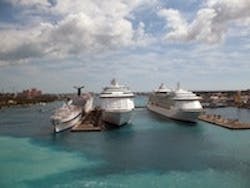California Sewage Ban Creates Largest Coastal No-Discharge Zone in the Nation
The U.S. Environmental Protection Agency’s (EPA) Pacific Southwest Regional Administrator Jared Blumenfeld signed a rule that will finalize EPA’s decision and approve a state proposal to ban all sewage discharges from large cruise ships and most other large ocean-going ships to state marine waters along California’s 1,624 mile coast from Mexico to Oregon and surrounding major islands. The action establishes a new federal regulation banning even treated sewage from being discharged in California’s marine waters.
This action strengthens protection of California’s coastal waters from the adverse effects of sewage discharges from a growing number of large vessels. Several dozen cruise ships make multiple California port calls each year, while nearly 2,000 cargo ships made more than 9,000 California port calls in 2010 alone. EPA estimates that the rule will prohibit the discharge of more than 22 million of the 25 million gal of treated vessel sewage generated by large vessels in California marine waters each year, which could greatly reduce the contribution of pollutants still found in treated vessel sewage.
State Senator Joe Simitian (D-Palo Alto) authored Senate Bill 771, the Clean Coast Act, which prohibits all commercial ships from dumping hazardous waste, sewage sludge, oily bilge water, “gray water” from sinks and showers, and sewage in state waters. Simitian’s SB 771 also required California to petition the federal government for a "No Discharge Zone" to enforce the bill’s anti-dumping provisions.
California’s coastal waters are home to a wide variety of unique, nationally important marine environments that support rich biological communities and a wide range of recreational and commercial activities. Four national marine sanctuaries, a national monument, portions of six national parks and recreation areas, and more than 200 other marine reserves and protected areas have been established to protect California’s unique marine resources.
The National Oceanic and Atmospheric Administration has already implemented similar vessel sewage discharge bans in the four California marine sanctuaries that it oversees. Recreational and commercial uses of California’s coastal waters are equally important. Seventy-seven percent of the state’s population lives on or near the coast and annually, more than 150 million visitor-days are spent at California beaches. California ranks first in the nation as a travel destination and its beaches are the leading destination for tourists. California’s commercial fishing industry also relies upon clean water to help preserve and restore coastal fisheries.
Under the Clean Water Act, states may request EPA to establish vessel sewage no-discharge zones if necessary to protect and restore water quality. In 2006, following passage of three state statutes designed to reduce the effects of vessel discharges to its waters, the state of California asked EPA to establish the sewage discharge ban. After releasing the proposed rule in 2010, EPA considered some 2,000 comment letters from members of the public, environmental groups and the shipping industry before finalizing the regulation.
The prohibition is unprecedented in geographical scope. In contrast to prior no-discharge zones under the act, which apply in very small areas, the new ban applies to all coastal waters out to 3 miles from the coastline and all bays and estuaries subject to tidal influence. Other California no discharge zones for ten bays and marinas remain in effect for all vessels.
Consistent with the state’s request, today’s prohibition applies to all passenger ships larger than 300 tons and to all other oceangoing vessels larger than 300 tons with sewage.
Source: EPA
